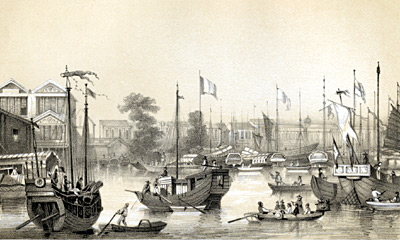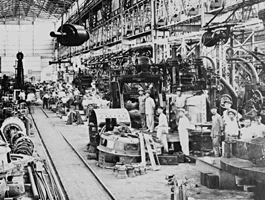China and Europe: 1780-1937
Differential Growth
China's Peripheries Decline
Meanwhile, in at least some of the Chinese hinterlands, the standard of living may still have been creeping up a bit, as handicrafts spread. But it was far short of Yangzi delta standards, and it now had much more weight in Chinese aggregates, causing the aggregates to sink. And ecologically, things did worsen in nineteenth-century China. But interestingly, not so much in the densely populated cores that you might have thought would be the most stressed areas, but in peripheral areas.
The northwest and southwest were seriously over-logged. Excessive reclamation in the middle Yangzi was increasing its vulnerability to flooding. And the water table fell sharply in the non-monsoonal hinterlands of the north and west, as their populations grew.
Late-eighteenth-century reports began noting that wells needed to be re-dug to make them deeper, a good sign of a falling water table. And by the early twentieth century, lake areas in these regions had shrunk dramatically.
The Asian Trade Boom

European factories along the harbor in Guangzhou in the nineteenth century.
Columbia University Libraries
I think most people know that the mid-nineteenth century is a period of considerable trauma and upheaval in East and Southeast Asia with the "opening" of Japan and later Korea, the French conquest of Indochina, and so on. And this is probably truest of all in China, where the mounting environmental problems we just discussed combine with a serious decline in the government's ability to manage problems—the opium trade, and other problems—to unleash four massive rebellions in the mid-nineteenth century, leaving tens of millions dead. We usually contrast this devastation and a rather slow recovery thereafter with the much more limited destruction, and much more impressive recovery, that occurs in Japan, where the Meiji Restoration is the outcome of years of fighting, too. In fact, we generally contrast a "successful" post-1850 Japan with an image of "failure" pretty much everywhere else in East Asia or even throughout Asia.
This contrast makes a lot of sense if we compare China as a whole to Japan as a whole, but we have to remember, again, that there are enormous differences of scale involved, and that significant parts of China—mostly along the coast—did much better, in part because they became part of a post-1870 trade boom that involved large portions of maritime Asia, from Manchuria all the way down to Singapore and then west to some parts of India. Like Japan, China's most advanced regions also resumed growth, adapted some new technologies, and benefited from new trading partners that partially replaced primary product in the Chinese interior.
Rice from Southeast Asia, for instance, replaced rice from Hunan in feeding Shanghai after 1870, and in feeding Canton after 1890. Timber from Manchuria and later from overseas replaced shipment that used to come along the Yangzi and so on.
Both the Manchurian and Southeast Asian trade booms are trends that predated 1840, but they continued thereafter at greatly accelerated rates. Advanced coastal regions sent miners, merchants, and for the first time, really huge numbers of farmers abroad, who sent back both earnings and land-intensive goods, gaining an informal empire of a sort at the same time that the Chinese empire, as conventionally understood, was cracking up. It's not the coast, but other regions that enter really prolonged crises.
Some, like the middle Yangzi, filled up and then plateaued, while others, such as north China, had real catastrophes, in part because ecological and political crises built on each other. The state was battered by rebellion, foreigners, and as it recovered, it also reoriented itself, beginning to emphasize coastal development, the building of a modern military, and other things needed to survive in a world of predatory nation-states. Money was often diverted from older priorities, with extremely painful results. For instance, the government stopped devoting massive resources to maintaining the Yellow River-Grand Canal junction after the mid-nineteenth century, shifting the money once used for this to paying indemnities, military modernization, and various projects in coastal areas that were both wealthier and more vulnerable to foreigners. The result was a massive increase in flooding in newly marginalized interior regions. The Qing government also stopped subsidizing well-digging in many dry areas, just as population growth and deforestation were lowering the water table in those areas, and so on. Thus, these interior areas suffered from the decreased interregional trade that had begun as they filled up in the late eighteenth century, and also suffered from losing state services that had once made population growth in ecologically fragile areas sustainable.
The Peripheries Affect the Core

A Mitsubishi plant in Kobe, Japan, c. 1925.
Library of Congress Prints and Photographs Division
The disorder in impoverished regions naturally spilled over into the rest of China, delaying any reconsolidation of the state. As one consequence of this, even the regional economies that did well in quantitative terms—and some like the lower Yangzi may actually have rivaled Japanese growth rates—did not make the kind of qualitative shifts into new kinds of industry that Japanese industry began making in the early twentieth century, often with heavy state assistance.
It's one thing to get textile production back on track, and find new markets for the Yangzi delta in Southeast Asia for instance. It's another thing to make the move into things like steel or chemicals. It requires both physical infrastructure and educational infrastructure of a kind that's very hard to imagine without a strong state. The Chinese simply didn't have one.
So if you look at the nineteenth century largely in terms of things that were new and turned out to be central to the twentieth century, such as mechanized industry and a strong national government, you see mostly failure and absence in China. But if you look forward from the eighteenth century, recognizing that all their concerns and dynamics didn't go away, you see those failures, but you see some other things too.
The 19th Century: An Awkward Era in World History
In fact, the nineteenth century in general is something of an awkward era in our narratives of world history, and East Asia highlights the awkwardness. Recent scholarship in early modern world history depicts multiple areas evolving along at least partially parallel tracks, even though the areas are only loosely connected to one other. But from roughly 1870 on, most world-history narratives emphasize a North Atlantic core, and represent the rest of the planet as reacting and dominated by new North Atlantic–derived criteria for gauging success.
A Fact Worth Pondering [VIDEO]
TRANSCRIPT: It's certainly significant, especially militarily, that within East Asia, only Japan developed heavy industry. But nonetheless, something was happening on Asia's Pacific coast more generally, that doesn't fit a "West-and-the-rest" framework. Even politically, though only Japan developed a modern Empire with a nation-state at its core, the Qing were not completely without imperial successes.
The suppression of central Asian revolts in the 1870s led to stronger control than before. And taking the longer view, it's worth remembering that unlike the Ottoman, Hapsburg, Romanoff, and other multi-national empires that came to grief after 1900, the Qing empire is still more or less unified today. And it's a fact that's worth pondering.
On another level, these regional processes I'm describing were increasingly fitted into a global division of labor, in which Chinese settlers, merchants, weavers, and so on, were de facto junior, very junior, partners of European colonial officials, bankers, railroad builders, and so on. It's a very unequal partnership to be sure, in which Europeans had the highest profits and the greatest power, but nonetheless it's one that protected and stimulated ongoing East Asian development, without reorienting the whole region outward toward the needs of Western industry, as imperial processes did in many other parts of the world.
The textbook examples usually used to epitomize late-nineteenth-century high imperialism are almost always taken from Africa, and they feature new conquests and massive plundering of resources across a very large technological gap. But elsewhere the balance of forces and division of labor were somewhat different. And East Asia stands at the opposite pole. Most of it was never formally colonized, and economically, it never became a major raw-materials exporter or industrial-goods importer.
In fact, many of its core regions imported more primary products than ever, as was true for the Yangzi delta, and sent the West light-industrial goods like silk and later cotton cloth, while continuing an ongoing elaboration of its own regional division of labor. From 1880 to 1913, intra-Asian trade actually grew considerably faster than east-west trade, and faster than international trade as a whole. And much of it developed as a sort of informal Chinese commercial sphere.